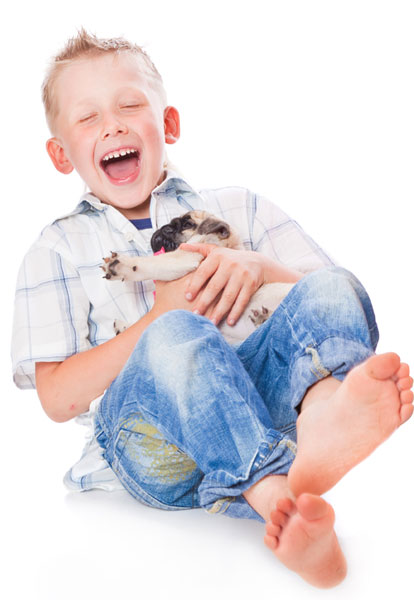If you see this icon in a fact sheet summary you may be dealing with a life threatening issue. Consult a veterinarian immediately.
Use our webform to ask a question or book an appointment

BLOAT (Gastric Dilation)
The condition described below — gastric dilation, or bloat — is a critical, life threatening emergency. If you suspect your dog is suffering from bloat call the hospital immediately (5756 2444), and get your dog here as quickly as possible. The sooner medical treatment is begun the greater the dog’s chances of survival.
Gastric Dilation and Volvulus, or GDV, is a syndrome of dogs in which the stomach dilates and twists around itself. Most people know the condition as ‘bloat.’ A serious, life-threatening condition, GDV is seen mainly in large or deep chested breeds such as Labradors, German Shepherds, Rottweilers, Great Danes, Saint Bernards or Alaskan Malamutes. On rare occasions it can affect Daschunds and other smaller dog breeds. It can occur at any age but is most common in middle aged to senior dogs.
The exact cause is unknown. Current research leads us to suspect that it is related to the way in which the stomach digests food. Normally, the stomach contracts in an orderly and systematic fashion when digesting food. With bloat it is believed that these contractions occur in a disorderly fashion, and the pyloris — the area leading to the small intestine — is shut off, preventing food moving into the intestine. Large amounts of air are also swallowed and, with the pyloris closed, that air cannot pass through out of the stomach.
In many cases, that leads to the stomach twisting on itself. Rapid overeating followed by exercise shortly afterwards is definitely a contributing factor. Breeds prone to GDV need to be trained to eat their food slowly, and exercise should be either before food, or at least an hour afterward.
SEVERITY: Critical. Requires urgent veterinary intervention
Dogs with bloat are usually in acute pain and distress, pacing and restless and will display non-productive retching or vomiting, and excessive salivation. Progressive enlargement of the abdomen, which can start to feel like a tight balloon, is a sign bloat is well advanced. Dogs with bloat are also usually weak and depressed. Without treatment this condition can lead to death within a few hours.
Bloat is potentially fatal for a number of reasons. As the stomach enlarges and twists the blood supply to the stomach is cut off, causing the tissue to begin to die and leading to the release of harmful toxins throughout the body. The expanding stomach also puts pressure on the lungs, preventing them from expanding and depriving the body of oxygen. As the stomach expands it also puts pressure on the major blood vessels (vena cava) resulting in disruptions of blood flow to various other body organs.
Diagnosis is often based initially on breed predisposition. On examination, the stomach will be obviously enlarged and very firm and the dog will be in considerable discomfort. An x-ray is performed and usually reveals a grossly enlarged stomach full of air. Sometimes the twist in the stomach can also be seen on the radiograph.
We’ll begin treatment by placing the dog on intravenous fluids to stabilise the patient and counteract shock. Once stabilised, a long tube will be passed through the mouth into the stomach to attempt to decompress the stomach. In many cases decompression is not possible using this method, but if decompression can be achieved this way the patient is better stabilised before the next step — surgical correction of the problem.
Whether the stomach is first decompressed or not, surgery must be performed to decompress (if not achieved with a stomach tube) and untwist the stomach. Usually the stomach is then permanently stitched to the side of the abdominal wall so it is held firmly in place and cannot twist again.
In some cases, the stomach will only fill up with air and not twist on itself. These dogs still need surgery to secure the stomach position and prevent it from twisting in the future. Without surgery there is an 80 per cent chance of a recurrence of bloat, compared to 3-5 per cent after surgery.
In cases where the blood supply to the stomach has been cut off for too long the stomach will look very blue or black in surgery. Sadly, these dogs will not survive and the kindest thing is to euthanise them.
Patients who have been treated for GDV require intense monitoring for at least 36 hours after surgery. A common problem post-surgery is cardiac arrhythmia — where the heart beats irregularly — caused by the heart receiving reduced oxygen during the bloating episode, causing parts of the heart muscle to be damaged, and also due to some of the toxins released after the stomach position is corrected.
Bloat is an extremely serious condition, and frequently fatal. In most cases where we cannot save the patient it’s often because the dog’s owner was unaware of, or failed to recognise, the initial symptoms and the patient reached the hospital too late for corrective surgery.
Dog parents should familiarise themselves with the signs of bloat and act swiftly if they suspect their dog is suffering from the condition. The sooner medical treatment is begun the greater the dog’s chances of survival. With prompt and appropriate treatment most dogs suffering from bloat that undergo surgery have a 55-70 per cent chance of recovery.
MORE DISEASES OF DOGS
DOGS: ADVICE FOR EMERGENCIES


